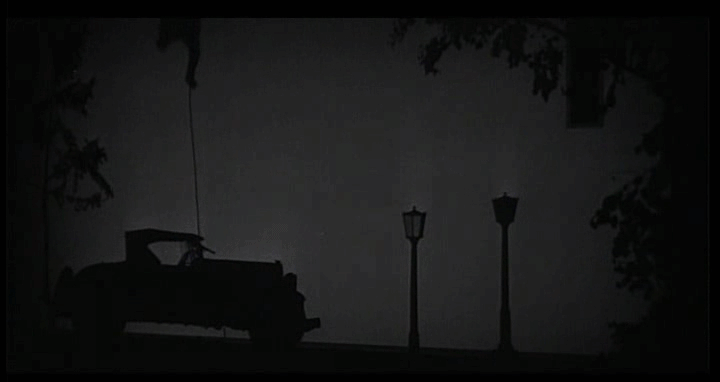Our discussion of The Bat Whispers covered: its melodramatic elements, which included the Mystery, Violence, Chase of male melodrama; the film’s origins in literature, stage and cinema; consideration of the narrative’s use of stereotypes and connections to the gothic; the relationship between Cornelia Van Gorder and Lizzie Allen; the film’s style, especially its camerawork, in terms of influence; the film’s epilogue.
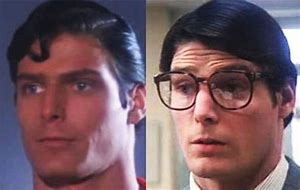 We began with discussion of elements relating to the ‘male’ melodrama: Mystery, Violence and Chase. These, especially the latter, were very much to the fore in our previous screening – Hunted (1952) starring Dirk Bogarde as a man on the run. This time, the criminal was the mysterious ‘Bat’, an inventive thief intent on terrorising the country. His unknown identity forms the film’s central mystery and means that we do not have access to his motives. The matter of disguise was also raised by another character. We noted how one of the film’s lesser character’s appearance, and poor attempt at passing for someone else, reminded us of a trope of the Superhero film. Dale Van Gorder (Una Merkel), niece of the elderly and indomitable Cornelia (Grayce Hampton) who is renting a country house for the summer, is anxious to hide her fiancé Brook (William Bakewell) in plain view as a gardener. In order to make sure he goes unrecognised (he is the missing clerk from a bank which has recently been robbed) Dale slightly ruffles Brook’s hair and gives him some spectacles. This made us think of the later depictions of Superman when he is passing for reporter Clark Kent. Other mystery elements arose as the film unfolded: who is responsible for the attacks on the characters?, who stole the money from the bank?, is the missing money in the house’s ‘hidden’ room?
We began with discussion of elements relating to the ‘male’ melodrama: Mystery, Violence and Chase. These, especially the latter, were very much to the fore in our previous screening – Hunted (1952) starring Dirk Bogarde as a man on the run. This time, the criminal was the mysterious ‘Bat’, an inventive thief intent on terrorising the country. His unknown identity forms the film’s central mystery and means that we do not have access to his motives. The matter of disguise was also raised by another character. We noted how one of the film’s lesser character’s appearance, and poor attempt at passing for someone else, reminded us of a trope of the Superhero film. Dale Van Gorder (Una Merkel), niece of the elderly and indomitable Cornelia (Grayce Hampton) who is renting a country house for the summer, is anxious to hide her fiancé Brook (William Bakewell) in plain view as a gardener. In order to make sure he goes unrecognised (he is the missing clerk from a bank which has recently been robbed) Dale slightly ruffles Brook’s hair and gives him some spectacles. This made us think of the later depictions of Superman when he is passing for reporter Clark Kent. Other mystery elements arose as the film unfolded: who is responsible for the attacks on the characters?, who stole the money from the bank?, is the missing money in the house’s ‘hidden’ room?
 The film contains several instances of violence. The Bat is reported by the newspapers to be a dangerous criminal, and we see him committing some violent acts. He murders a man he is robbing near the beginning of the film’s narrative, and we presume that he is also responsible for the onscreen shooting of Dick Fleming (Hugh Huntley) as well as other incidents. He is not the only violent character though. Fleming was threatening Dale with a gun at the time he was shot; Dr Venrees (Gustav von Seyffertitz) hits Detective Anderson (Chester Morris) over the head with a telephone; the caretaker (Spencer Charters) drops an urn from a height on a visitor when he appears on the doorstep. Some of this violence is, however, undercut by the film’s often comic tone. This mostly exists in the characters, especially those coded as of the lower classes. Specifically, these are Cornelia’s maid Lizzie (Maude Eburne) and the caretaker. The former’s responses to the violence, and indeed any mild instances of terror, are always exaggerated while the latter is demonstrably fearful of all strangers.
The film contains several instances of violence. The Bat is reported by the newspapers to be a dangerous criminal, and we see him committing some violent acts. He murders a man he is robbing near the beginning of the film’s narrative, and we presume that he is also responsible for the onscreen shooting of Dick Fleming (Hugh Huntley) as well as other incidents. He is not the only violent character though. Fleming was threatening Dale with a gun at the time he was shot; Dr Venrees (Gustav von Seyffertitz) hits Detective Anderson (Chester Morris) over the head with a telephone; the caretaker (Spencer Charters) drops an urn from a height on a visitor when he appears on the doorstep. Some of this violence is, however, undercut by the film’s often comic tone. This mostly exists in the characters, especially those coded as of the lower classes. Specifically, these are Cornelia’s maid Lizzie (Maude Eburne) and the caretaker. The former’s responses to the violence, and indeed any mild instances of terror, are always exaggerated while the latter is demonstrably fearful of all strangers.
 The film’s central narrative line is the search for the Bat. But the dynamic and suspenseful chase sequences which open the film – police cars race down city streets – are replaced by comic ones in the house. The most extended of these involves the caretaker being pursued though the house by the police. As well as involving one of the film’s demonstrably ‘comic’ characters, the footage also appears to be sped up. There are also scenes during which the Bat dashes through the house, making an exit through centrally placed chute. This has a comic effect, but this is increased when it the action is repeated, with comical noises and gestures, by Lizzie. The chase sequences also effectively establish the onscreen space, giving us insight into the house’s architecture. (We noted, for example, the connecting doors between Cornelia and Lizzie’s rooms.) The house’s construction becomes especially important as the location of a ‘hidden’ room, potentially the place where the missing money is being stashed, is sought. This therefore links both the mystery and chase elements present in the film.
The film’s central narrative line is the search for the Bat. But the dynamic and suspenseful chase sequences which open the film – police cars race down city streets – are replaced by comic ones in the house. The most extended of these involves the caretaker being pursued though the house by the police. As well as involving one of the film’s demonstrably ‘comic’ characters, the footage also appears to be sped up. There are also scenes during which the Bat dashes through the house, making an exit through centrally placed chute. This has a comic effect, but this is increased when it the action is repeated, with comical noises and gestures, by Lizzie. The chase sequences also effectively establish the onscreen space, giving us insight into the house’s architecture. (We noted, for example, the connecting doors between Cornelia and Lizzie’s rooms.) The house’s construction becomes especially important as the location of a ‘hidden’ room, potentially the place where the missing money is being stashed, is sought. This therefore links both the mystery and chase elements present in the film.
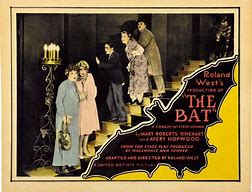 While these specific melodramatic elements are more connected to the ‘male’ melodrama, we also commented on the film’s use of more ‘traditional’ melodrama stereotypes. These are worth considering in relation to the film’s stage origins, and its early sound cinema production context. The film is based on the play, The Bat, written by Mary Roberts Rinehart and Avery Hopwood in 1920. It enjoyed popularity, closing after over 800 performances in New York, and more than 300 in London. The play was also praised by leading American theatre critic Alexander Wollcott in the New York Times. It had previously been filmed, by The Bat Whispers director Roland West, as a silent in 1926. That version starred Emily Fitzroy as Cornelia, Louise Fazenda as Lizzie and Eddie Gribbon as Detective Anderson.
While these specific melodramatic elements are more connected to the ‘male’ melodrama, we also commented on the film’s use of more ‘traditional’ melodrama stereotypes. These are worth considering in relation to the film’s stage origins, and its early sound cinema production context. The film is based on the play, The Bat, written by Mary Roberts Rinehart and Avery Hopwood in 1920. It enjoyed popularity, closing after over 800 performances in New York, and more than 300 in London. The play was also praised by leading American theatre critic Alexander Wollcott in the New York Times. It had previously been filmed, by The Bat Whispers director Roland West, as a silent in 1926. That version starred Emily Fitzroy as Cornelia, Louise Fazenda as Lizzie and Eddie Gribbon as Detective Anderson.
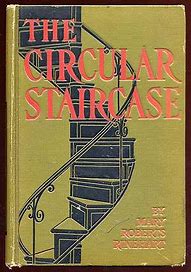 It is notable that both the 1926 and 1930 films draw on the play, rather than Roberts Rinehart’s original 1908 novel The Circular Staircase. This had been directed by Edward le Saint as a feature-length silent in 1915. The novel and the 1915 film notably differ to the 1920 play and subsequent film adaptations. Many of the characters’ names are altered, but more significant changes are the exclusion of Cornelia’s nephew, and the addition of the titular criminal. The latter complicates the still-present bank robbery narrative. Although these divergences are important, it is perhaps because of the earlier film, and the question of rights, that the relationship between The Circular Staircase and The Bat was denied by Roberts Rinehart. It was also able to draw more directly on the play’s commercial success.
It is notable that both the 1926 and 1930 films draw on the play, rather than Roberts Rinehart’s original 1908 novel The Circular Staircase. This had been directed by Edward le Saint as a feature-length silent in 1915. The novel and the 1915 film notably differ to the 1920 play and subsequent film adaptations. Many of the characters’ names are altered, but more significant changes are the exclusion of Cornelia’s nephew, and the addition of the titular criminal. The latter complicates the still-present bank robbery narrative. Although these divergences are important, it is perhaps because of the earlier film, and the question of rights, that the relationship between The Circular Staircase and The Bat was denied by Roberts Rinehart. It was also able to draw more directly on the play’s commercial success.
Furthermore, we can relate some changes to the difference in media. While the novel is told from Cornelia’s point of view, and in retrospect, the play and the 1926 and 1930 films are more action-based. This helps to explain the fact that the characters are not psychologically rounded, but mostly stock types. These generally either propel the plot (commit a crime, investigate it) or provide comic relief – especially the servants. We partly related the exaggerated style of some of the acting to the genre (comic mystery melodrama) especially with the comic characters. The timing of the film, and the long history of the story are also important. The Bat Whispers appeared at the start of the sound era. Its very title announces this fact, and the Bat does indeed whisper his threats to those he wishes to intimidate. While not all previous silent film acting is of the exaggerated type, theatrical gestures and overstatement were used in earlier film. Such a claim is reinforced when we also consider the long history of the narrative (the novel was published in 1908) – even in 1930 it may well have seemed dated to audiences.
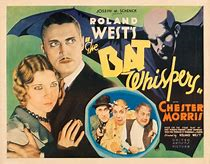 There is some nuance however. This is mostly due to the fact that the Bat’s real identity, he is posing as Detective Anderson, is unknown for most of the film and only revealed in the last few minutes. It is important that the character we might think of as the hero – top billed Chester Morris (arguably the only real ‘star’) – turns out to be the villain. This is encouraged by some of the extratextual materials, in particular a lobby card which privileges Morris and Merkel, even suggesting a romance which does not materialise. The supporting cast is present, but with smaller pictures of the elderly retainers such as Lizzie. This prompted some reflection on the relationship between stars and ageing. The conflation of the hero and villain was accompanied by a blurring as to the identity of the victim. Perhaps a legacy of its stage origin and, as outlined above, the addition of the Bat character, the film’s focus is somewhat diffuse. Those characters who are subjected to deadly violence are exclusively men, although those behaving like victims (portraying fear etc) do not necessarily split along gender lines. Instead, the division between the brave and the cowardly is along class lines since the servants Lizzie and the caretaker are the most scared. These are also elderly, though its is certainly the case that the aged Cornelia is dignified and unflappable throughout.
There is some nuance however. This is mostly due to the fact that the Bat’s real identity, he is posing as Detective Anderson, is unknown for most of the film and only revealed in the last few minutes. It is important that the character we might think of as the hero – top billed Chester Morris (arguably the only real ‘star’) – turns out to be the villain. This is encouraged by some of the extratextual materials, in particular a lobby card which privileges Morris and Merkel, even suggesting a romance which does not materialise. The supporting cast is present, but with smaller pictures of the elderly retainers such as Lizzie. This prompted some reflection on the relationship between stars and ageing. The conflation of the hero and villain was accompanied by a blurring as to the identity of the victim. Perhaps a legacy of its stage origin and, as outlined above, the addition of the Bat character, the film’s focus is somewhat diffuse. Those characters who are subjected to deadly violence are exclusively men, although those behaving like victims (portraying fear etc) do not necessarily split along gender lines. Instead, the division between the brave and the cowardly is along class lines since the servants Lizzie and the caretaker are the most scared. These are also elderly, though its is certainly the case that the aged Cornelia is dignified and unflappable throughout.
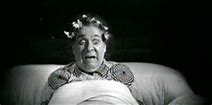 Despite our consideration of the mystery, violence and chase of male melodrama, we discussed the female characters, and their relationship to the gothic, at length. The old dark house in which the action takes place encourages a consideration of the film as gothic. However, the film’s diffuse focus affected the male persecutor/female persecuted dynamic of its women in peril. Significantly, all three women fulfilled the role of active investigator. Cornelia calls in a professional investigator, and Dale is anxious to prove her fiancé’s innocence, searching the house with a lit candle. Lizzie does so to a lesser extent but sets a ‘bear trap’ attached to her bed which means she will be alerted if the trap is engaged. This provides one of the film’s best comic moments as Lizzie is indeed later propelled through her bedroom window in her onesie as the Bat is caught in her trap and drags her bed towards the window. Cornelia is certainly not a suffering heroine, but Lizzie is constantly scared, and Dale is distressed when she is trapped in the hidden room.
Despite our consideration of the mystery, violence and chase of male melodrama, we discussed the female characters, and their relationship to the gothic, at length. The old dark house in which the action takes place encourages a consideration of the film as gothic. However, the film’s diffuse focus affected the male persecutor/female persecuted dynamic of its women in peril. Significantly, all three women fulfilled the role of active investigator. Cornelia calls in a professional investigator, and Dale is anxious to prove her fiancé’s innocence, searching the house with a lit candle. Lizzie does so to a lesser extent but sets a ‘bear trap’ attached to her bed which means she will be alerted if the trap is engaged. This provides one of the film’s best comic moments as Lizzie is indeed later propelled through her bedroom window in her onesie as the Bat is caught in her trap and drags her bed towards the window. Cornelia is certainly not a suffering heroine, but Lizzie is constantly scared, and Dale is distressed when she is trapped in the hidden room.
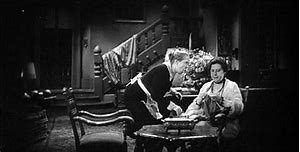 Unlike the usual gothic heroine, these women are not menaced by a husband. Cornelia and Lizzie are unmarried and even Dale’s fiancé only plays a small role. We were especially intrigued by the relationship between Cornelia and Lizzie. While the latter dresses as a maid and is treated in some ways like a servant by Cornelia, who gives her orders, there are mentions that the servants have fled. Perhaps Lizzie is excepted from consideration as staff since she is such an old retainer. More telling however, is the way Lizzie responses to Cornelia addressing her like an idiot child. Being told by Cornelia that she doesn’t have a mind, Lizzie sharply retorts that if she had one her employer would not let her use it. She also lists some of the ‘fads’ she has remained loyal to Cornelia through: theosophy, suffragism, and, as implied by Lizzie’s tone, most appallingly of all, socialism. They bicker like a couple.
Unlike the usual gothic heroine, these women are not menaced by a husband. Cornelia and Lizzie are unmarried and even Dale’s fiancé only plays a small role. We were especially intrigued by the relationship between Cornelia and Lizzie. While the latter dresses as a maid and is treated in some ways like a servant by Cornelia, who gives her orders, there are mentions that the servants have fled. Perhaps Lizzie is excepted from consideration as staff since she is such an old retainer. More telling however, is the way Lizzie responses to Cornelia addressing her like an idiot child. Being told by Cornelia that she doesn’t have a mind, Lizzie sharply retorts that if she had one her employer would not let her use it. She also lists some of the ‘fads’ she has remained loyal to Cornelia through: theosophy, suffragism, and, as implied by Lizzie’s tone, most appallingly of all, socialism. They bicker like a couple.
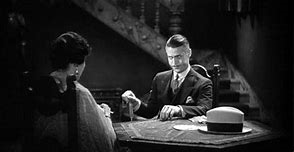 The film certainly has its stagey moments, and there are some dialogue-heavy scenes. We were, however, impressed with some of the camerawork which was possible during scenes which were less dependent on bulky sound equipment for synchronous sound recording. The opening scenes are action-filled and employ miniature vehicles convincingly. We also noted some of the swooping, bat-like, movements of the camera in relation to the miniature used to represent the house. The film’s lighting and shadow-work were praised. The revelation that ‘Detective Anderson’ is the Bat is prefigured by a change in the way his face is lit. While earlier his exaggerated and somewhat comical facial
The film certainly has its stagey moments, and there are some dialogue-heavy scenes. We were, however, impressed with some of the camerawork which was possible during scenes which were less dependent on bulky sound equipment for synchronous sound recording. The opening scenes are action-filled and employ miniature vehicles convincingly. We also noted some of the swooping, bat-like, movements of the camera in relation to the miniature used to represent the house. The film’s lighting and shadow-work were praised. The revelation that ‘Detective Anderson’ is the Bat is prefigured by a change in the way his face is lit. While earlier his exaggerated and somewhat comical facial gestures are lit in a straightforward manner, after his return from his altercation with the telephone, he appears to be far more menacing. Many of the images of the Bat in silhouette reminded us of German film director’s Lotte Reiniger’s work. The uncanny turning of bat from shadows into a moving figure was also deemed effective.
gestures are lit in a straightforward manner, after his return from his altercation with the telephone, he appears to be far more menacing. Many of the images of the Bat in silhouette reminded us of German film director’s Lotte Reiniger’s work. The uncanny turning of bat from shadows into a moving figure was also deemed effective.
 We also noticed the generic nature of the buildings portrayed. Some of these especially emphasised its function – e.g. a BANK. This brought to mind comic books. Such a connection is furthered by Bob Kane (the creator of Batman) who mentioned in his autobiography the influence The Bat Whispers had on his creation of the superhero. The film’s sets and style were also compared to Wes Anderson’s The Grand Budapest Hotel (2014). More straightforwardly, the film was remade in 1959 (by Crane Wilbur) and for television in various countries.
We also noticed the generic nature of the buildings portrayed. Some of these especially emphasised its function – e.g. a BANK. This brought to mind comic books. Such a connection is furthered by Bob Kane (the creator of Batman) who mentioned in his autobiography the influence The Bat Whispers had on his creation of the superhero. The film’s sets and style were also compared to Wes Anderson’s The Grand Budapest Hotel (2014). More straightforwardly, the film was remade in 1959 (by Crane Wilbur) and for television in various countries.
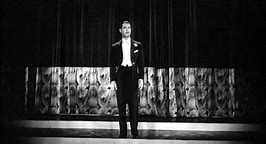 Appropriately we closed our discussion by commenting on the film’s epilogue. This has Chester Morris, in evening dress, in front of a curtain which mimics that of a theatre stage of film theatre He speaks on behalf of his ‘friend’ the Bat and asking that his identity is not divulged by members of the audience. This seems especially appropriate for a sound film, and the keeping of the secret was also referenced in advertising for the 1959 film version. Significantly in The Bat Whispers this is done through the person of the star, and the one who plays the Bat, reminding us that the Bat indeed just a role Morris has played. This doubles the melodramatic element of disguise, pointing us once more to the conventions of the genre and its suitability for the medium of film.
Appropriately we closed our discussion by commenting on the film’s epilogue. This has Chester Morris, in evening dress, in front of a curtain which mimics that of a theatre stage of film theatre He speaks on behalf of his ‘friend’ the Bat and asking that his identity is not divulged by members of the audience. This seems especially appropriate for a sound film, and the keeping of the secret was also referenced in advertising for the 1959 film version. Significantly in The Bat Whispers this is done through the person of the star, and the one who plays the Bat, reminding us that the Bat indeed just a role Morris has played. This doubles the melodramatic element of disguise, pointing us once more to the conventions of the genre and its suitability for the medium of film.
As ever, do log in to comment, or email me on sp458@kent.ac.uk and let me know that you’d like to add your thoughts to the blog.

